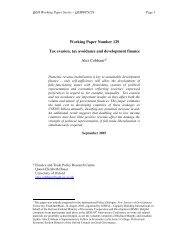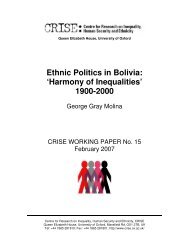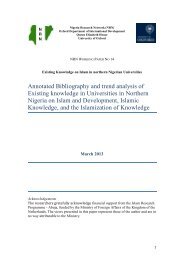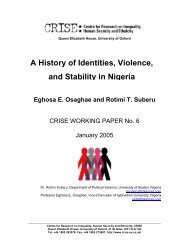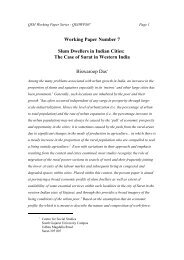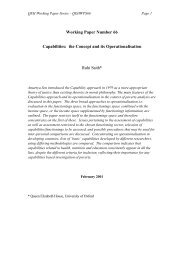Acute Multidimensional Poverty: A New Index for Developing ... - OPHI
Acute Multidimensional Poverty: A New Index for Developing ... - OPHI
Acute Multidimensional Poverty: A New Index for Developing ... - OPHI
Create successful ePaper yourself
Turn your PDF publications into a flip-book with our unique Google optimized e-Paper software.
<strong>Acute</strong> <strong>Multidimensional</strong> <strong>Poverty</strong>: A <strong>New</strong> <strong>Index</strong> <strong>for</strong> <strong>Developing</strong> CountriesAlkire & SantosMortalityIn terms of the mortality indicator, in DHS and WHS there is a general question on mortality (nonagespecific), as well as a birth history that collects in<strong>for</strong>mation on the age at death, allowing theconstruction of the age-specific indicators. In MICS, ENSANUT, and ENNyS there is only ageneral question on mortality (non-age specific). There are three exceptions to this in MICS:Somalia, Yemen, and Iraq also contain birth histories, which would allow the construction of theage-specific mortality indicator. To guarantee comparability across surveys, we use a non-age specificindicator of mortality. A household (and there<strong>for</strong>e all its members) is considered deprived if therehas been a child death, no matter the age. 41Years of educationDHS contains in<strong>for</strong>mation on the years of education <strong>for</strong> each household member. In MICS we hadto build it from two questions: highest educational level achieved and highest grade completed inthat level, considering the duration of each educational level in each country. 42 We are aware thatthere is measurement error in this variable. However, we think this does not have a significantimpact on the MPI indicator, as this only requires determining whether each household member hasfive years of education or not, regardless of how many exact years he/she has completed.In WHS, there is in<strong>for</strong>mation on the number of years of education completed by the respondent.For other household members there is only in<strong>for</strong>mation on the accomplished level. We considerthat at least someone in the household has completed five years of education if: (a) any householdmember has completed secondary school or more, or (b) the respondent has completed five years ofeducation or more, or (c) the maximum level of education of the household is incomplete orcomplete primary and the median number of years of education of all respondents with thateducational level is five or more.In ENSANUT, the variable was constructed as it was in MICS. Finally, in ENNyS there is onlyin<strong>for</strong>mation on the educational attainment of the household head and the respondent (who is eithera woman 10-49 or a child who is measured), so the household is considered non-deprived ineducation if either the household head or the respondent have completed five years of education.Child School AttendanceIn DHS, the school attendance question draws on one of two questions: 1) whether the child iscurrently attending school or 2) whether he or she attended school in the previous year. Whichquestion was implemented varies by country. To construct the indicator of child school attendance,we have adjusted the age to each question. 43 In MICS, ENSANUT, and ENNyS the variable refersto whether the child is currently attending school. In WHS – quite un<strong>for</strong>tunately – there is nothe MGRS reference population. We have computed the MPI using both reference populations and have records of thedifference. This is discussed in the section on Results.41 For a robustness check, we computed an alternative measure using the under-5-years-of-age mortality indicator <strong>for</strong>those countries in which this is available. We comment on this in Section 4.7.42 The duration of each level in each country was taken from United Nations Educational, Scientific and CulturalOrganization (UNESCO) Institute <strong>for</strong> Statistics database, Table 1. “Education systems”http://stats.uis.unesco.org/unesco/TableViewer/tableView.aspx?ReportId=163). Given that UNESCO determines theduration according to the International Standard Classification of Education, this in<strong>for</strong>mation was contrasted with eachdataset and country-specific in<strong>for</strong>mation and adjusted whenever necessary.43 For example, if the schooling age is 6-14 years old and the question refers to the previous year, this applies to children7-15; if it refers to current year then it applies to age 6-14. In<strong>for</strong>mation on the age at which children start school in eachcountry was taken from UNESCO, Institute <strong>for</strong> Statistics database.www.ophi.org.uk July 2010 24



